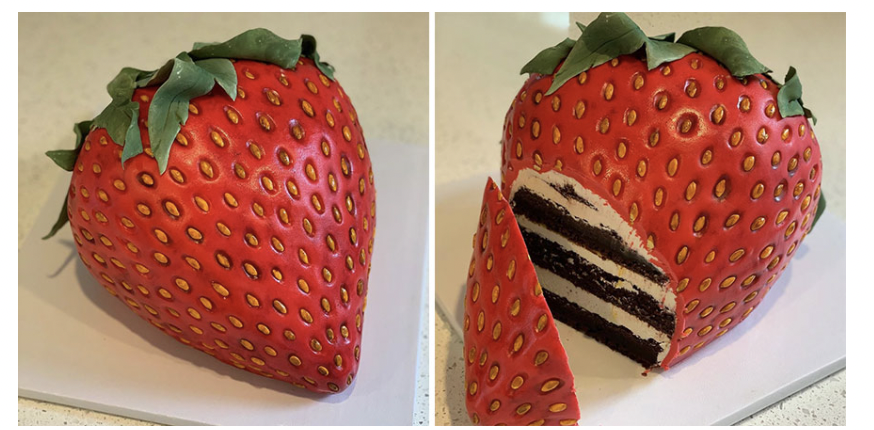At Least He Was Right About the Cake Thing?

Pictured above (via here) is a cake that looks like a strawberry. The version on the left, unsliced, could easily pass for a real piece of fruit. It’s very nice to look at and one can fairly marvel at the artistry of the cake creator. But if you want to experience what the cake sculpture tastes like, you’ll need to slice into it, as seen on the right, and then eat it — and in doing so, you’ll destroy the illusion and ultimately, the cake itself. The cake above is the proverbial saying “you can’t have your cake and eat it, too” brought to life. You can either have the strawberry cake on display, or you can eat the sweet dessert. But you can’t have both.
And yet, that saying seems a little off. You can “have your cake” — that is, you can look at the strawberry and appreciate the craft that went into making it — and then you can eat it, enjoying the sugary treat that it actually is. As Wikipedia’s editors note, “Some find the common form of the proverb to be incorrect or illogical and instead prefer: ‘You can’t eat your cake and [then still] have it (too).’ Indeed, this used to be the most common form of the expression until the 1930s–1940s, when it was overtaken by the have-eat variant.” And really, that version makes a lot more sense, right?
So, why did the idiom switch? That’s not clear. But one thing is: if you’re intent on blowing people up, you probably should just go with the more common, modern version of the saying, even if it is seemingly illogical. Because being pedantic about idioms focused on the logic of cake-eating may get you arrested.
On May 25, 1978, a campus police officer fell victim to one such bomb, mailed to the school by someone at the time unidentified. Over the course of the next decade and a half, the criminal would mail at least another 15 bombs, killing three people and injuring 23 others. Finally, in the fall of 1995, the man called the “Unabomber” by law enforcement, but otherwise unidentified, offered to call it quits — with one condition attached. The Unabomber wrote a 35,000 word manifesto and sent it to the Washington Post, New York Times, and others. If they published his novella-length treatise in their paper, he would “desist from terrorism.” On the urging of the FBI, both of the two major papers cited above published the essay, which you can read here.
You probably won’t read it — it’s a rambling mess arguing that the Industrial Revolution was a “disaster for the human race” and doesn’t make for a great read. But at the time, the mystery around the identity of the sociopathic bomber intrigued many, including a man named David Kaczynski. David’s wife, Linda, had urged him to read the full thing, as some themes reminded her of the rants of David’s reclusive brother, Theodore (Ted) Kaczynski. And David immediately saw some phrases that reminded him of Ted. One passage that jumped off the page: “As for the negative consequences of eliminating industrial society—well, you can’t eat your cake and have it too. To gain one thing you have to sacrifice another.” The bomber used the much less common, but historically proper, “eat-have” formulation. The New York Times explained what happened next:
A young Theodore J. Kaczynski learned from his mother that “you can’t eat your cake and have it too” was the correct way to say it. When Kaczynski later penned an anarchist manifesto in the guise of the Unabomber, the appearance of that particular turn of phrase helped F.B.I. analysts, working with Kaczynski’s brother David, identify who the author was and bring him to justice for his mail-bombing spree.
Specifically, as Language Log explains, “Following David’s hunch, Fitzgerald’s team of agents and analysts made a more systematic comparison of the Manifesto with letters written by Ted Kaczynski to his brother and mother. The idiosyncratic use of the ‘cake’ expression, among other stylistic evidence presented in the FBI’s affidavit, was enough to convince a judge to issue a search warrant for Kaczynski’s cabin in Montana.” Ted was arrested on April 3, 1996 and pled guilty to ten counts of bomb making. He served the rest of his life in prison.
Bonus fact: The Unabomber’s nickname caused a linguistic kerfuffle of its own. As JSTOR Daily explains, the code name that the FBI gave him came from his targets and his methods — he was the “UNiversity and Airline BOMber,” or “UNABOM.” The FBI unit focused on finding him was called the UNABOM division as a result. And when Ted Kaczynski was ultimately arrested, the press often referred to him as the “Unabomer” — without the second, silent “b.” But that was weird to readers everywhere. As the New York Times Magazine explains, “In Unabomer, the e signals the pronunciation of the previous vowel as a long o: ‘bome,’ rhyming with ‘home.’ But the perp is a bomber, not a ‘bomer’; without the second b, the word looks as if it should rhyme with ‘Homer.’ After considerable internal anguish (once a word has been spelled one way on two covers, editors feel committed to that spelling), Newsweek bowed to the pressure of readers and other publications and put in the second b. At The New York Times, the policy decision was Unabomber from the start; all the cases of dropped b’s were typos or errors by journalists who didn’t get the word.”
From the Archives: Why We have a Silent B: This isn’t about the Unabomber but after that bonus fact, it’s a perfect next read, right?
